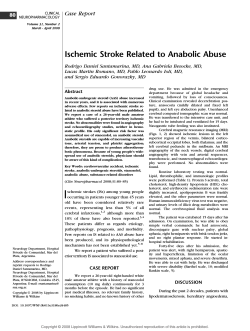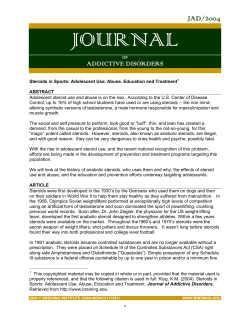
Psychiatric Perspective Treating Steroid
Treating Steroid Abuse: A Psychiatric Perspective Giannini, MD* Norman Miller, MD** Deirdre K. Kocjan, LSW† A. James Anabolic-androgen steroids (AAS) are indicated medically for specific conditions, particularly androgen deficiency. However, because of their apparent capacity to improve physical and psychological performance, young athletes have been using AAS to increase competitiveness and self-image. AAS act on skeletal muscle to increase nitrogen retention and protein synthesis, thus increasing muscle size and strength. Aggressivity, euphoria and diminished fatigue are produced by effects on central nervous system androgen receptors. Psychiatric effects include depression, hyperaggressivity, mania and psychosis. Physical problems include cardiovascular abnormalities, hypertension, and tumor formation. Women report anovulation and virilization. Currently, over one million Americans have used AAS to enhance athletic performance or increase muscle mass. Nearly three-fourths of this group are high school students. Four to ten percent of all high school boys and 0.5% to 2.5% of all high school girls have misused steroids. In addition, 20% of college athletes, 80% of male bodybuilders and 40% of female body builders use AAS as performance enhancers. Most steroids are purchased through illegal sources: these include veterinary AAS and those of illicit manufacture. In addition, physicians provide a small source of these steroids despite state sanctions against this practice. Most exogenous steroid abuse can be directly detected by chromatography-mass spectrometry but the technique is tedious and expensive. If detection is not needed for legal purposes, a ratio of urinary testosterone to epitestosterone that is greater than 6:1 1 is usually sufficient to diagnose misuse of AAS. Withdrawal from AAS usually involves three steps: detoxification, rehabilitation and after-care. Inpatient detoxification is indicated only if there are severe physical problems or psychosis. Treatment is then directed towards the sequelae of anabolic steroid abuse as the steroids are withdrawn. Rehabilitation can be conducted on an in-patient or outpatient basis. The modalities are psychotherapeutic and include individual, group and milieu therapy, as well as rigorous physical therapy. Because of the long-term nature of the recovery process, weekly attendance at self-help addiction groups such as Narcotics Anonymous is strongly encouraged. On the basis of high prevalence and severe side-effects, and other physicians treating adolescents should be alert for anabolic steroid abuse in their practice. The expense and difficulty involved in direct laboratory testing, necessitate careful history taking and examination. If steroid abuse is detected, treatment is mandatory. Thus, careful attention to the patient’s history and proper psychotherapeutic treatment modalities are all necessary components in attending to this serious drug problem. pediatricians Introduction *Clinical Professor of Psychiatry, Ohio State University, Columbus, Ohio, Medical Director, Chemical Abuse Centers, Inc., Austintown, Ohio. **Assistant Professor of Psychiatry, Cornell University Medical College, White Plains, New York. †Counselor, New Start Treatment Center, Warren, Ohio. Correspondence to: A. James Giannini, MD, P.O. Box 2169, Youngstown, Ohio 44504. The anabolic-androgen steroids possess two interrelated functions. These synthetic analogues of testosterone, possess anabolic actions which increase muscle mass and enhance kinetic performance. Their androgenic actions replicate the virilizing effects of male sex hormones. Shortly after the drugs were first reported to have an ability 538 Downloaded from http://cpj.sagepub.com at Cape Breton University Library on September 6, 2008 to maintain a positive nitrogen balance in castrated dogs, the research goal became enhancement of anabolic effects and diminishment of androgenic ones. Possibly for this reason, this class of steroids is referred to as simply &dquo;anabolic steroids.&dquo; During World War II, these steroids were used to increase aggressivity and muscle mass in soldiers. 1,2 early 1950’s, anabolic steroids began to be disweight rooms of American gymnasiums. Weightlifters used them to increase their strength and body-builders to increase their muscle mass. Gradually, other athletes began using them to become bigger, faster, In the tributed in the meaner, and to improve endurance. Steroid use is so albeit covertly, that athletic coaches expect that their athletes will use steroids to maintain a competitive edge. Steroids approved for therapeutic uses include: Winstrol (stanozolol), Dianabal (methandrostenolone) and Durabolin (nandrolone phenpropionate). These are the steroids commonly used by athletes, in addition to illegal and veterinary steroids which have no approved therapeutic uses in humans. 2,4 Steroid usage was recently brought into the public eye in 1988 when Ben Johnson, winner of the gold medal for the 100-meter dash, was disqualified because of steroid use. Although Johnson did pass the drug test immediately after the race, his world record for the 100-meter dash was disallowed by the International Amateur Athletic Federation when he admitted to using steroids in his training regimen. This action led to passage of the Federal AntiDrug Abuse Act of 1988. It also prompted individual states to enact criminal penalties for the distribution or possession of anabolic-androgenic steroids. Johnson later stated that had he known the adverse effects of steroids, he would not have used them. Usage has been linked to cardiovascular abnormalities, benign and malignant tumors, change in cholesterol levels, hypertension, sterility, inhibition of ovulation (in women), acne and virilization. Although the adverse effects of steroids are pronounced, muscle mass and strength can be enhanced only if the athlete is in an intensive weight-training program when he initiates steroid use and then continues this program by increasing nitrogen retention and promoting a greater rate of muscle-protein synthesis: increased aggressivity and diminished fatigue also occur probably as a result of direct action on specific central androgen widespread, receptors.47 Although reasons for the illegal use of steroids vary, taking them can be compared to the introduction of drugs or alcohol to the addict. As in the case of other more &dquo;classical&dquo; addictions, the steroid abuser may be intro- duced to the drug by the influence of peer pressures. A particular drug subculture then acts to maintain illicit drug use. Similar dynamics are found in both drug addiction and steroid use. The chemically dependent person, along with the steroid users may experience behavior changes that include moodiness, hyperaggressivity, fluctuating libido and a decreased self image. Both types of users may also report incidents of manic behavior and bouts of major depression. As steroid use continues, a false sense of self develops. Steroid users, may discover that in prolonged use of anabolic-androgenic steroids, their lives are unmanageable and out of control. The psychological dependence, peer pressure and black-market purchasing of steroids can also become a trigger or gateway to other addictions. 7-1 , Prevalence It has been estimated that over one million Americans have used anabolic steroids to enhance athletic performance or increase muscle mass. Most begin using these steroids during late adolescence. Of this number, nearly 700,000 are high school students. The prevalence for high school boys ranges from 4% to 10% and for girls, 0.5% to 2.5%. Though actual rates of prevalence have been difficult to obtain, 20% of college athletes have been reported to misuse steroids.’ Most astonishing is the 80% usage rate among male body builders and 40% rate among their female counterparts.’ Reasons cited for use include: increased aggressivity; &dquo;bulking&dquo; (i.e. increasing muscle mass); prolonged endurance; increased strength and overall improvement of performance.’-&dquo; Most steroids are purchased through illegal sources. In many cases, however, athletes have been able to secure steroids from physicians, some of whom disagree with a blanket prohibition of steroids. This is done despite sanctions which many states have levied against any medical doctor prescribing these class of drugs to enhance performance. In other states, published reports of steroid toxicity have reduced the number of physicians willing to prescribe these drugs. This has apparently increased the demand for black market and veterinary steroids. 5,14-18 Biochemistry and Physiology The anabolic steroids vary in their structure, route of administration, duration of action, relative effects and toxicities. All anabolic steroids can be classified into two major chemical groups: 17-alpha-alkylated and 17-esterified steroids. The esters are usually given intramuscularly, producing a longer duration of action than oral 539 Downloaded from http://cpj.sagepub.com at Cape Breton University Library on September 6, 2008 administration. Because there is substantial breakdown of the testosterone molecule after oral administration by the first pass through the liver via the portal system, alkylation with a methyl or ethyl group protects against hepatic oxidation of the 17-beta-hydroxy moiety following an oral dose. However, the alkylated derivatives are not as safe as testosterone itself due to higher risk of hepatic toxicity.’ 9~2° The androgens are four-ringed structures with 19 carbon atoms. Hydroxy or ketone groups are found at C-3 and C17. Testosterone, the major androgen in humans, is secreted mainly by Leydig cells in testicular interstitial tissues. As a class, androgens are responsible for the male phenotype in utero. They stimulate the development of male sexual organs and promote the voice deepening, sebaceous gland secretion and the male body hair pattern in the axilla, trunk, limbs and face.2’ Their anabolic effect is to promote stimulation of the growth of the muscle mass during its normal development. Receptor binding in the nucleus increases RNA production which, in turn, increases protein synthesis. Because no anabolic steroid is free from androgenic effects, the unavoidable consequence of high-dose steroid use is virilization. Anabolic and androgenic activities are not caused by different structural components of the molecule but by different receptor effects in different tissues. The actions of these steroids are less specific because the anabolic-responsive muscles contain the same receptor system as the other androgen-target tissues. Therefore, all anabolic agents have androgenic activity and can produce androgen effects. In fact, they are used in therapy for their free plasma concentration. This results in saturation of receptor sites and eventual toxicity. ’ Intoxication The effects of intoxication have medical and psychiatric consequences. The use of anabolic steroids has been associated with heart attacks, strokes, liver disease, tumors and cancer, high blood pressure, fluid retention, altered immunity and skin abnormalities. Men may develop sterility, testicular atrophy, painful gynecomastia, prostatic hypertrophy and hair loss. Women may develop sterility, menstrual irregularities, masculination with deepening of voice, increase in body hair and clitoral hypertro- phy_26-30~1> Psychiatric effects include depression, mania, suicidal ideation, insomnia, marked aggression and violent behavior, mood swings and frank psychosis. Many steroid users suffer from psychotic and depressive disorders that are similar to DSM-III-R criteria for these diagnostic categories. Adolescents and preadolescents can experience premature epiphyseal closure. Children may also develop virilization or feminization. Male children also have a pronounced gynecomastia.26,3I Tolerance and Dependence Both tolerance and withdrawal symptoms occur with anabolic steroids. Studies show that tolerance was detectable in 20% and withdrawal symptoms in 84% of a group of users. The withdrawal syndrome is characterized by androgen replacement.22 anorexia, decreased libido, depression, fatigue, insomnia, restlessness, as well as psychological cravings.3z Pharmacokinetics Patterns of Use Testosterone is readily absorbed after oral dosing, but has poor bioavailability due to a rapid first-pass effect so that only 50% reaches the circulation. Methyltestosterone, a synthetic androgen, is less extensively metabolized by the liver and has a longer half-life, which improves the bioavailability after oral administration. The half-life of testosterone is variable, ranging from 10 to 100 minutes. Nandrolone decanoate, given intramuscularly, has a mean half-life of six days. Nandrolone exhibits a linear pharmacokinetics behavior (dose independent) similar to other types of steroids, including prednisolone and methylpred- nisolone.I2,23-25 With liver disease, there is a decrease in both the rate of . metabolism of the anabolic steroids and the synthesis of the plasma proteins responsible for their binding. Because anabolic steroids can cause liver damage, repetitive use of larger doses of these steroids by athletes tend to increase The user typically uses 10 to 100 times the therapeutic dose, and often does not know the exact composition of the AAS because of the illicit source. The steroids are often mixed from more than one source in order to achieve the high doses desired: this combination usage is referred to as &dquo;stacking.&dquo; The combination may be given entirely intramuscularly or with a mixture of oral and intramuscular preparations. In using the stacking technique, the intent is that the additive effects of the various steroids will decrease an additive increase in side effects. In stacking, the dosages and identities of the various steroids are frequently changed when noticeable increases in muscle mass or strength are no longer achieved. The steroid user frequently consumes other drugs to control side effects from the steroids. Diuretics are taken to reduce the fluid retention from the mineralocorticoid effect of steroids. Estrogen blockers, such as clomiphene 540 Downloaded from http://cpj.sagepub.com at Cape Breton University Library on September 6, 2008 or tamoxifen, are used to prevent steroid-induced gynecomastia. Human chorionic gonadotropin is used to reduce the testicular atrophy that is induced by androgenic effects on the pituitary secretions of the male gonadotropin, FSH.Is-lS The preoccupation with acquisition and compulsive use of anabolic steroids has been documented in clinical practice and in research studies. Some steroid users maintain that they would not stop taking AAS even if it was proven beyond a doubt that AAS caused permanent sterility, liver cancer, or heart attacks. For those patients who do quit using anabolic steroids, a generalized steroid withdrawal state has been documented. 32 The prevalence of multiple drug use is high in the steroid addicts. These drugs include the sympathomimetics such as amphetamine and cocaine, as well as marijuana and alcohol. It should be noted that alcohol blocks the metabolism of conjugated estradiol and increases the feminization effect of steroids. 17,18,33 Detection High risk groups for steroid use and addiction include weightlifters and body builders as well as high school, college and professional athletes. Also, anyone using recreational drugs or overusing alcohol is at risk for steroid abuse. Psychiatric problems such as depression, explosiveness, fatigue, mania or psychosis in these population groups should further raise the suspicion index for steroid use. Any unexplained cardiac, endocrine, or hepatic abnormality should also be evaluated as a possible effect of misusing steroids. A drug problem should be investigated by both a diagnostic interview and laboratory testing The diagnostic interview should center upon a nonjudgemental attitude which simultaneously does not condone or collude with the pattern of abuse. Indirect symptomatic clues, or preferably, the frank admission of an abuse pattern should be sought. Drug testing for detection of steroid use involves identification of the steroid and the metabolite. Because some of the exogenously administered AAS, such as testosterone esters are metabolized to testosterone, it is necessary to calculate ratios to distinguish quantitative differences from endogenous sources of testosterone. Normally, the ratio of testosterone to epitestosterone in the urine of males is 1-2.5:1. When the ratio exceeds 6: l, the use of exogenous testosterone compounds is probable. The steroids that are not metabolized can be detected by their presence in the urine.&dquo; It is important to refer to a laboratory that can competently perform testing for steroids. While false negative results are far more common than false positive results, a well regulated laboratory can be expected to minimize the likelihood of either. Drug testing for steroids is intricate and involves testing for 40 different steroid compounds: the gas chromatography-mass spectrometry methodology is quite expensive and difficult.&dquo; In all cases, the consent of the adolescent’s parents is advised.3¢ Treatment Detoxification does not ordinarily require specific pharmacological intervention. Supportive medical and psychiatric care for the sequelae of use of these drugs may be needed, i.e. hepatic toxicity or suicidal intent. Administration of hormonal replacement may be indicated in severe cases of hypothalamic suppression of the gonado- tropins. As with other drug addictions, denial and rationalization must be confronted. In the case of anabolic steroids, denial takes a unique form. Since the steroids do not ordinarily produce intoxication, the addict generally justifies the beneficial effects including enhanced performance and increased muscle mass. Such justifications ignore the paucity of objective support of performance claims. The occurrence of tolerance and withdrawal symptoms associated with their use as well as known harmful effects mark high-dose anabolic steroid use as an addiction. If it is accepted that steroid addiction is no different than any other addiction, then treatment can also be formulated according to generally accepted principles for chemically dependent patients. Treatment is divided into three phases: inpatient detoxification, inpatient or outpatient short-term rehabilitation recovery therapy and long-term aftercare ’ recovery.35 Inpatient detoxification is indicated only for the presence of severe physical sequelae of frank psychosis.&dquo; No current &dquo;magic bullet&dquo; such as clonidine for opiate use or bromocriptine for cocaine use currently exists for anabolic steroids.35 Inpatient treatment is also indicated for multiple drug abusers who are detoxified from their other addictions, as well as, and for the dual diagnosis patient (i.e. patients with both drug dependence and psychiatric disorders). In addition to detoxification, individual, group, and milieu psychotherapeutic modalities are routinely of the personality and motivation of Because employed. the typical anabolic steroid addict, rigorous physical therapy is a sine qua non of the inpatient treatment program. Recovery therapy can be conducted on an inpatient or outpatient basis. Treatment outcomes are not different when compared by location.36 Most programs operate on 541 Downloaded from http://cpj.sagepub.com at Cape Breton University Library on September 6, 2008 12-step model developed by Alcoholics Anonymous. Ideally, the addict is able to finally admit that he has a problem and that, while he is responsible for it, he cannot resolve it without the help of others. A combination of peer-group support therapy, family therapy and individual counseling provide the therapeutic mix for this phase.37 Since addiction is a recurring or continuous life-long disease, long-term therapy is indicated when the recovery phase is ended. This is sometimes called the &dquo;aftercare phase.&dquo; It usually involves regular attendance at Narcotics Anonymous meetings. Some drug treatment programs also offer life-long after-care programs for their &dquo;graduates.&dquo; The use of telephone &dquo;help lines&dquo; are also useful during this phase of treatment. Individual psychotherapy and group therapy can be utilized during the detoxification, rehabilitation and/or the long-term recovery period. Commonly these modalities are directed at the &dquo;here and now&dquo; conflicts of the multiply dependent. Supportive, confrontational or cognitive approaches are the most effective in directing the multiply-dependent patient to avoid occasions of abuse. Special education and counseling regarding steroid use and complications as well as alternatives to improving athletic performances should be conducted either by the pediatrician or a specialist in this some form of the area. References 1. Haupt HA, Rovere GD. Anabolic steroids: Am J Sports Med 1984; 12:469-84. a review of the literature. 2. Kochakian CD, Murlin JR. The effect of male hormone on protein and energy metabolism of castrated dogs. J Nutr 1935; 10:437-59. 3. Martin DM, Dozoretz RI, Weinstein ME. Clinical implication of federal regulations in laboratory testing for alcohol and drugs of abuse. In: Miller, NS (ed). Comprehensive Textbook of Drug and Alcohol Addiction. New York, Marcel Dekker, 1991, pp. 825-41. 4. Kopera H. The history of anabolic steroids and a review of clinical experience with anabolic steroids. Acta Endocrinologica, Suppl 1985; 271:11-18. 5. Wilson JD. Androgen abuse by athletes. Endocr Rev 1988; 9:181-99. 6. Sheridan PJ. Androgen receptors in the brain: what are we measuring? Endoc Ren 1983; 4:171-8. 7. Lombordo JA, Longcope C, Voy OR. Recognizing anabolic steroid abuse. Patient Care 1985; 19:28-47. 8. Johnson MD, Jay MS, Shoup B, et al. Anabolic steroid use by male adolescents. Pediatr 1989; 82:921-4. 9. Bell JA, Doege TC. Athletes use and abuse of drugs. Phy Sports 1987; 15:99-108. 10. Lamb DR. Anabolic steroids in athletics: how well do they work and how dangerous are they? Am J Sports Med 1984; 12:31-8. 11. Miller NS, Giannini AJ. The disease model of addiction: the biopsychiatrist’s view. J Psychoactive Drugs 1990; 122:83-5. 12. Buckley WE, Yesalis CE, Friedl K, et al. Estimated prevalence of anabolic steroid use among male high school seniors. JAMA 1988; 260:3441-5. 13. Dezelsky TL, Toohey JV, Shaw RS. at five United States universities: a Non-medical drug use behavior 15-year study. Bull Narc 1985; 37:49-53. 14. Coward V. Steroids in sports: after four decades, time to return these genies to bottle? JAMA 1987; 257:421-7. 15. Bergman R, Leach RE. The use and abuse of anabolic steroids in Olympic-caliber athletes. Clin Ortho Related Res 1985; 198 :16972. 16. Frankle MA, Cicero GJ, Payne J. Use of androgenic anabolic steroids by athletes. JAMA 1984; 252:482. 17. Pope HG Jr., Katz DL, Champoux R. Anabolic-androgenic steroid use among 1,010 college men. Physician Sports Med 1988; 16 :7581. 18. Pope HG Jr, Katz DL. Affective and psychotic symptoms associated with anabolic steroid use. Am J Psychiatry 1988; 145:487-90. 19. Gower DB. Steroid Hormones. London: Croom Helm, 1979. 20. Van Wayjen RGA, Buyze G. Clinical pharmacological evaluation of certain anabolic steroids. Acta Endocrinol (suppl) 1962; 63:18. 21. Griffin JE, Wilson JD. Disorders of the testes and male reproductive tract. In: Wilson JD, Foster DW, (eds.) Textbook of Endocrinology, 7th ed. Philadelphia: Saunders, 1985:259-311. 22. Desauller PA, Krahenbhl C. Evaluation and mode of action of anabolic steroids: differentiation of action of various anabolic steroids. In: Gross F, (ed.) Protein Metabolism. Berlin: SpringerVerlag, 1962:185. 23. Smith RG, Nag A, Syms AL, et al. Steroid receptor, gene structure and molecular biology. J Steroid Biochem 1986; 214:51. 24. Tepperman J. Metabolic and Endocrine Physiology Yearbook. Chicago: Medical Publisher, 1973:70. 25. Nowakowski H. Metabolic studies with anabolic steroids. Acta Endocrinal, (suppl.) 1962; 63:37. 26. Kibble MW, Ross MB. Adverse effects of anabolic steroids in athletes. Clin Pharm 1987; 6:686-92. 27. McNutt RA, Ferenchick GS, Kirlin PC, et al. Acute myocardial infarction in a 22-year-old world class weightlifter using anabolic steroids. Am J Cardiol 1988; 62:164. 28. Mochizuki RH, Richter KJ. Cardiomyopathy and cerebrovascular accident associated with anabolic-androgenic steroid use. Physician Sports Med 1988; 16:109-14. 29. Ishak KG, Zimmerman HJ. Hepatotoxic effects of the anabolic/ androgenic steroids. Semin Liver Dis 1987; 7:230-6. 30. Creagh TM, Rubin A, Evans DJ. Hepatic tumors induced by anabolic steroids in an athlete. J Clin Pathol 1988; 41:441-3. 31. DSM-III-R: Diagnostic and Statistical Manual of Mental Disorders, 3rd ed. Washington, DC: American Psychiatric Association, 1987. 32. Brower KJ, Blow FC, Beresford TP, et al. Anabolic-androgenic steroid dependence. J Clin Psychiatry 1989; 50:31-3. 33. Johnston LD, O’Malley PM, Bachman JG. 5th Annual National Survey of American High School Seniors. University of Michigan News and Information Services. Ann Arbor, Michigan, 1990. 34. Miller NS, Giannini AJ, Gold MS, et al. Drug testing: medical, legal and ethical issues. J Substance Abuse Treatment 1990; 7:239-44. 35. Dandidiker WB, DeSaussare VA. Fluorescence polarization in immunochemistry. Immunochem 1970; 7:799-828. 36. Miller NS. A primer of the treatment process of alcoholism and drug addiction. Psychiatry Newsletter 1987; 5:30-37. 37. Giannini AJ. Un Modello biopsichiatrico per riconoscere la tossicomania. Ricerca e Salute 1991; 2:4-9. 542 Downloaded from http://cpj.sagepub.com at Cape Breton University Library on September 6, 2008
© Copyright 2025

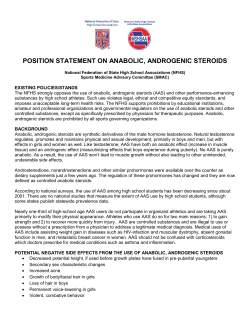
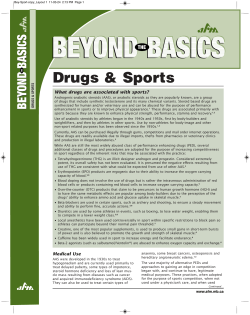

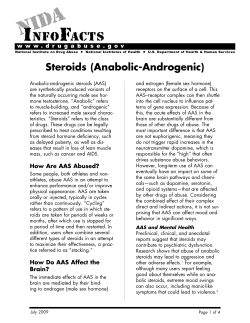




![” ⊙ Prohibited Substances [1] Anabolic-Androgenic Steroids](http://cdn1.abcdocz.com/store/data/000006330_2-6488874179c020189ebf4ca4aba01440-250x500.png)

